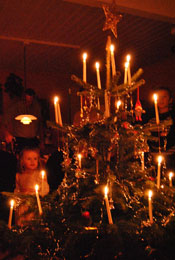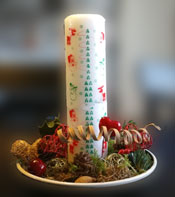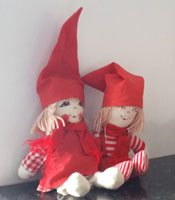A Danish Christmas
 To state it simply; Christmas (Jul) is a very big deal in Denmark. Expect to see lots of candles. Although Danes think of themselves and the country as on the cutting edge of the 21st Century, a visitor who had the opportunity to spend time with a Danish family at Christmas would find a festival that is in many ways reminiscent of a simpler time.
To state it simply; Christmas (Jul) is a very big deal in Denmark. Expect to see lots of candles. Although Danes think of themselves and the country as on the cutting edge of the 21st Century, a visitor who had the opportunity to spend time with a Danish family at Christmas would find a festival that is in many ways reminiscent of a simpler time.
The entire month of December is dominated by Christmas.
In any town large enough to have a shopping district the streets and shops will be decorated with fir tree branches and Christmas lights. Town squares and gardens will be filled with Christmas trees decorated with “fairy lights” (strings of quite small lights that create a shimmering effect). The lights add great cheer, warmth, and appeal to the streets.
The weather in Denmark at this time of year can be cold and wet. The days are short. As the sun sets around 3:30 in the afternoon in the days leading up to Christmas, perhaps that is why Danes appreciate and enjoy the festive and charming mood created by the lights. Certainly, Danish families go out of their way to make Christmas a special time of year.
Although the majority of Danes can be classed as agnostic or atheist, the county technically has a high church membership. The “Folkekirken” (People’s Church) is financially supported by the state, and over 80% of Danes are “members”. The net effect is that Christmas themes with religious origins remain an important part of Christmas, whether from habit or from tradition.
 Many homes will have an Advent Wreath; an evergreen wreath graced with the four candles that mark the Sundays before Christmas. The custom presumably came to Denmark from Germany. The traditional Advent Wreath consists of spruce twigs and cuttings, which may be decorated with red berries and spruce cones, white candles and red ribbons to attach the wreath to the ceiling. Another tradition is the Christmas candle. Many families will light this Christmas candle as the month progresses. It is a candle with 24 markings (one for each day leading up to the big day), and will be lit each day as a calming influence during the lead up to Christmas. The candle burns through the marking set aside for the day and is blown out when it reaches the next marking…, only to be relit the next day.
Many homes will have an Advent Wreath; an evergreen wreath graced with the four candles that mark the Sundays before Christmas. The custom presumably came to Denmark from Germany. The traditional Advent Wreath consists of spruce twigs and cuttings, which may be decorated with red berries and spruce cones, white candles and red ribbons to attach the wreath to the ceiling. Another tradition is the Christmas candle. Many families will light this Christmas candle as the month progresses. It is a candle with 24 markings (one for each day leading up to the big day), and will be lit each day as a calming influence during the lead up to Christmas. The candle burns through the marking set aside for the day and is blown out when it reaches the next marking…, only to be relit the next day.
There are also “Christmas Calendars” on television. The main television channels produce daily Christmas programming which is directed at youngsters, and serves to keep the children in a state of excitement through the month.
Houses across Denmark will place candles and lights in their windows which provides yet another illustration of the importance of lights in the celebration of Christmas. In the Catholic Church Saint Lucia is the “saint of light” and this provides yet another opportunity to light candles and small lights to decorate their homes and houses. This happens on Lucia night: December 12th.
One of the major sources of amusement to children in the lead up to Christmas is the “nisse”, a mischievous elf that is only somewhat connected with Julemand (Santa Claus). Unlike the elves that make the toys for Christmas, a nisse will play pranks on children. He may mysteriously turn on lights, or leave unusual presents for the child in the days preceding Christmas.
The big day is the evening of December 24th. As mentioned earlier, religious themes appear at Christmas. Many people will attend a church; largely to listen to the carols.
Most people eat roast duck on Christmas Eve, but roast goose or roast pork are also popular. The duck or goose is stuffed with apples and prunes and served with white and sweet potatoes, red cabbage and beets and cranberry jam. Dessert is almost always a rice pudding with cream which may be served with a hot cherry sauce by the very traditional.
The rice pudding dessert will contain one or more peeled almonds hidden within. The lucky person who finds the almond will receive a small present to honor their luck in finding the almond treasure. Not surprisingly, it is almost always one of the children that discovers the almond in their pudding.
Where possible, the children will not see the Christmas tree until dinnertime on Christmas Eve. The tree will have been secretly decorated with various paper hearts and homemade decorations, along with the unlit candles. Danish Christmas trees have far simpler decorations than North American.
 Lastly comes the Christmas ceremony itself. The Danish family will light the actual tree candles and then gather around the Christmas tree to sing Christmas carols and songs. Typically they will hold hands and circle the tree in one direction while they sing a carol and then reverse direction for the next carol. The last song is fun for all and the same in all households. They sing a very short Christmas song (“Nu det jul igen”) faster and faster while circling the tree faster and faster. You reverse directions each time the verse is sung, and by the last repetition, the family is literally running around the tree. (all the while holding hands)
Lastly comes the Christmas ceremony itself. The Danish family will light the actual tree candles and then gather around the Christmas tree to sing Christmas carols and songs. Typically they will hold hands and circle the tree in one direction while they sing a carol and then reverse direction for the next carol. The last song is fun for all and the same in all households. They sing a very short Christmas song (“Nu det jul igen”) faster and faster while circling the tree faster and faster. You reverse directions each time the verse is sung, and by the last repetition, the family is literally running around the tree. (all the while holding hands)
After the carols are complete comes the big moment for children and adults…, the presents. No mad rush of everyone opening presents simultaneously…, the presents will be distributed one by one. After playing with their gifts for a bit, the children will be sent off to bed (it’s been a long day) and the adults will socialize.
December 25th is a quiet day; oriented around the more extended family.
Unlike New Year’s, Christmas is very much a family occasion in Denmark. Nearly every store or public venue is closed and the Danes enjoy the time with their family.
How do I say "Merry Christmas" in Danish? Glædelig Jul!
LastUpdate: 2019-12-20 21:31:42
